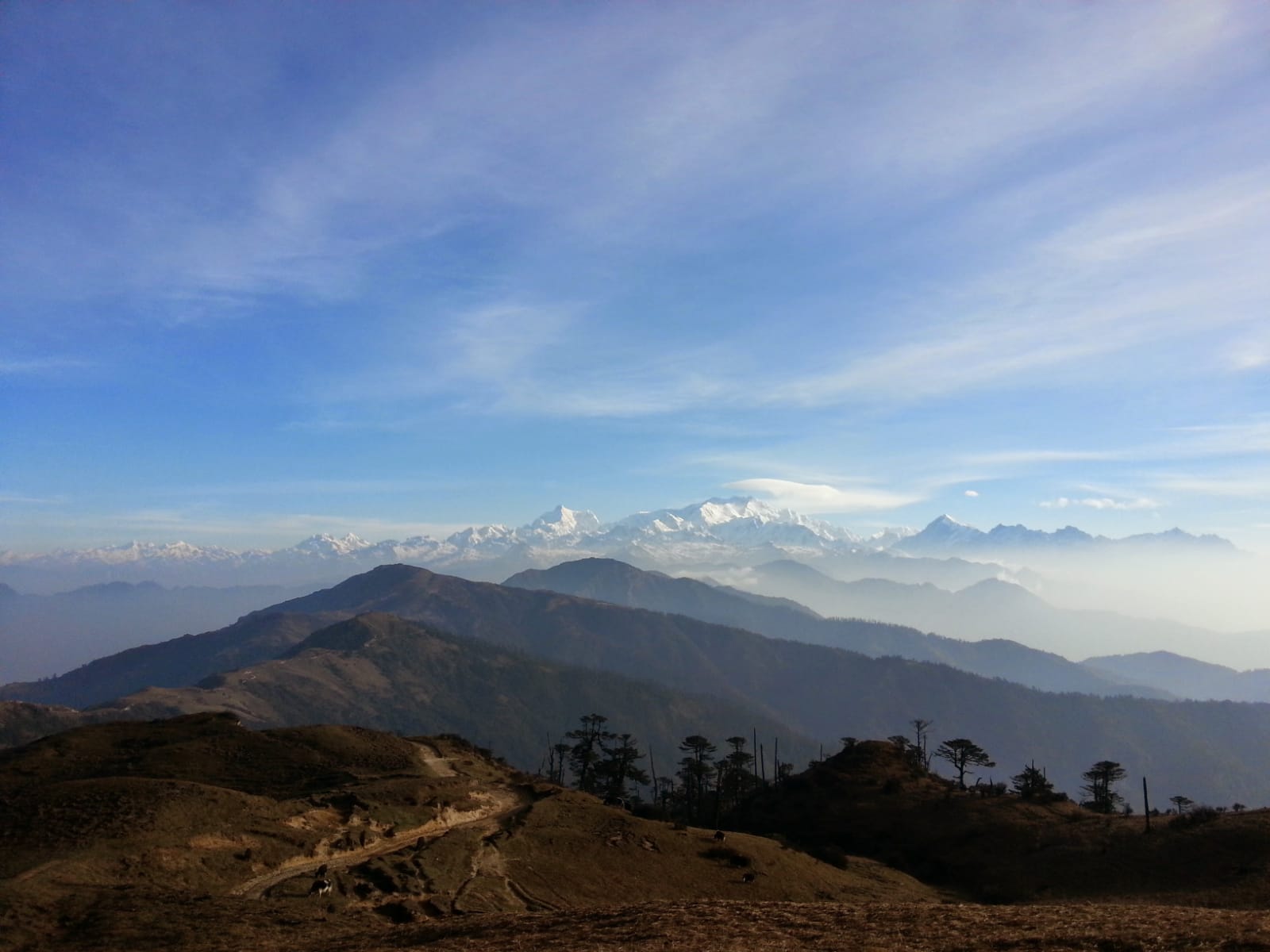Singalila and SikkimTrekking

On of the best memories.
-
Day 1
Delhi –Bagdogra - Gangtok : Meet the guide at the airport and drive to Gangtok. we must come to Gangtok to get the permit for the trekking or if you apply the Inner line Sikkim permit their itself then we can drive same day to Pelling (126 km / 05 hrs.). Overnight hotel.
-
Day 2:
Gangtok to Pelling – 124 kms 5hrs After receiving the trekking permit we will drive to Pelling stay there for a night as an acclimatization night.
-
Day 3
Pelling to Uttarey. 35 kms 200 mt: After breakfast drive to Utteray, this is the far western border area between Nepal, on the way we will visit some trout farming, traditional
-
Day 4:
Uttarey to Chiwa Bhanjyang - 4 hours :For eight days we thread our way up and over the highest reaches of the Singalila Ridge, which forms the border between Sikkim and Nepal. We may meet the occasional yak herder but we are well beyond permanent settlements. The names given to places around here however exotic it may sound to your ear, are basically associated with their purpose, such as high pastures, passes and ridge points. We pass through a rich forest cover, swathes of rhododendrons, open ridges, sacred lakes and remote passes. Our first day takes us to Chiwa Bhanjyang (3,100 m). An easy trail rises gently through rainforest until a final steep ascent for the last couple of hours bring us to the Nepalese border and our first camp.
-
Day 5
Chiwa Bhanjyang to Dhor - 7½ hours. Camp 3800m :A gentle uphill traverse through forest and then over a more exposed hillside brings us to prayer flags adorning our first pass and views of distant mountains - a taste of what is to come. As we gradually gain height we will appreciate the previous day’s acclimatization. The occasional yak herder’s hut is the only sign of habitation as we look down far below to the rice fields and cardamom plantations. Our camp is in a remote and sheltered hollow below the ridge.
-
Day 6:
Dhor to Pare Megu - 6 hours. Camp 3800m :Rising just before dawn, a five-minute walk onto the ridge may reveal the spectacular sight of sunrise on both Everest and Khangchendzonga. Throughout the day we descend and climb, maintaining a steady height, spiralling from one side of the ridge to the other until a rough steep ascent takes us across a pass. Beyond, the trail wends its way steadily through rhododendrons and past several Hindu shrines where a second easier pass drops down to our camp close to a shepherd’s summer settlement. Look out for the Blue Sheep on the high craggy mountainside.
-
Day 7
Pare Megu to Lam Pokhari - 4½ hours. Camp 4300m : We walk easily on a good trail through forest until we begin a steady rise up a broad valley where we catch our first closer view of the entire Kabru range dominated by Mount Pandim (6,691m). A further 2 hours of ascent will get us to our camp with Everest and a host of other Khumbu giants dominating the distant skyline.
-
Day 08: Lam Pokhari to Gomathang - 6 hours. Camp 3900m
Now we are in high mountain country and the forests lie far below. For the past two days we have been walking in Nepal and today we pass the sacred lake of Lam Pokhari, which marks our entry back into Sikkim. A little snow underfoot can be expected as we climb to our first pass, the Danphe Bhir La at 4,530 meters, the Pass of the Pheasant. From here it is possible to see the whole of Sikkim with the view stretching out well into Tibet and Bhutan. A further hour’s contouring and a small ascent reveals the Kag Bhir La (the Pass of the Crow) where we may be lucky enough to view a panorama of Himalayan peaks including Khangchendzonga. Reluctantly, we then must head downhill making a steep descent to our riverside camp.
-
Day 9:
Gomathang to Tikip Chu - 8 hours. Camp 3850m: We leave our lovely meadow camp to climb through forests of sweet smelling silver fir and rhododendrons. Soon we are in high mountain terrain again. Look out for the brightly colored Danphe birds (Impeyan Pheasant), which nest in the high crags around the Kamsey La, 4,200 m. As we drop down into the meadows of Kokling, we are already looking up at our next pass of 4,300 m. that we reach with a steady ascent up a steep crag to a skyline dominated by the dizzying pinnacles and icy cliffs of Kanchenjunga. Once again we end the day’s hike with a steep descent to our campsite by the Tikip Chu, which has its source high on the Rathong mountains (6,679 m.).
-
Day 10:
Tikip Chu to Dzongri - 3 hrs. 4,030 m:Today our route joins the regular trail up to the Goecha La. A steady climb through ancient fir forest, juniper and rhododendrons gradually opens out to the summer pastures of Dzongri. Another high camp, but we should be well acclimatized by now probably in contrast to some of the trekkers we meet who could be on day 3 of their Dzongri Trek at 4,000 m.
-
Day 11
Dzongri to Tshoka - 3 hours. Camp at 3,000 m: On new ground today, we follow the traditional route back to the main valley. Tshoka is an enchanting little Tibetan settlement perched on a mountain spur. It will be our first encounter on this trek with permanent village life, and the novelty of having a roof over our heads will add a new dimension to the journey. We can also see the Red Panda as you already saw before.
-
Day 12
Tshoka to Yuksam: Last day of the trek as you already know the landscape, stay overnight at Yuksam.
-
Day 13
Darjkeeling -Bagdogra airport drop: After brreakfast drive to Bagdogra airpori. Tour Ends



